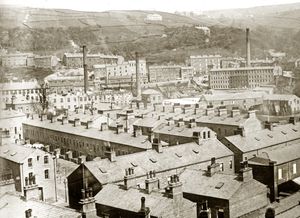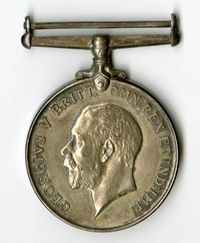
Brothers at War: Tom Crossley Brown
Tom Crossley Brown was born to Richard and Anne Brown, the youngest of seven siblings and was one of three Brown brothers who fought in the First World War. Working as a clothier prior to the war at the family business, R. B. Brown, and Sons, he worked in a lower position compared to his other brothers like Robert (Bert) who owned the business or Fred who was a manager. This meant that he was drafted into the war earlier than his brothers, as they were seen as more essential to the war effort at home.
Originally Tom was conscripted into the West Yorkshire Regiment in February 1916 and was trained in York. However, he transferred into the British Exploration Force (BEF), where he fought in the German Spring Offensive in Spring 1918. During this time, he was injured and was sent back to England for the rest of the war. Throughout his time in France, he was in frequent contact with his eldest brother Bert asking about the family business, the well-being of his other brothers in France and telling him about the harsh conditions on the front lines.

The British War Medal, awarded to all that served during the First World War. Pennine Horizons Digital Archive HCC00179.
The exact battle that Tom was injured in during the German Spring Offensive is unknown, however by his regiment and the date of his letters it can be deduced that it was one of the first battles in Spring 1918, most probably either Operation Michael (March 21st, 1918 - April 5th, 1918) or The Battle of Lys (9th April - 29th April 1918). Both battles resulted in devastating consequences for the BEF. In Tom’s letter dated “May 10th, 1918”, he wrote to Bert:
After we'd gone on the "top" I had orders to get into communication with H.'.s on my left while my section shell-holed, when the ground got up and hit me in the leg and then I fell down. Thought I "So this is the hero's death", the stink of sulphur was frightful, the noise was hellish and a machine-gun pop-popped the devil's music just in front of me. "I lie here until the agony comes on and then bleed to death".
The letter gives graphic detail of what it was like during battles on the Western Front, details that were often censured from letters back home. The two battles ended in British victory, however the BEF suffered mass casualties and injuries. This resulted in the British military using reserve troops to fill the gaps of the front line trench, caused by the deaths. Despite the situation he found himself in, Tom managed to work his way back, telling Bert:
So, I got hold of my rifle for a bullet of mine to have a home. But I got in the shape of what I took to be my answer to that idea, a bullet in my right hand so I took the hint and dragged myself to a trick and fell asleep or something else. Probably the whole thing was cowardly but one is scarcely oneself at these times. This is between you and me.
Tom’s actions would have made him a deserter of the British Army, a crime with the punishment of death. The understanding of why troops deserted the military is more understood today, as we have a greater understanding of mental health, especially the condition of Shell Shock that became prominent amongst troops in the trenches. From other letters from Fred to Bert we become aware that Tom was struggling from his mental health during and prior to the war, with Tom’s health and recovery being frequently written about between the two brothers. Fred wrote to Bert saying:
The pater has kept me posted with news of Tom, it seems there is plenty of room for the lad to improve, hope he does so too.
A contributor to this stigma was the correlation of common symptoms of the condition including deafness, paralysis and shock being associated with hysteria, a mental illness that was attributed to women. There was also the fear of being labelled a coward by peers and society. Following the war Shell Shock was not seen as a legitimate medical condition and was looked on as a temporary condition. This resulted in veterans not receiving the appropriate military pensions in Britain throughout the twentieth century.
There is not much information of Tom’s life after the war, however we know from a 1939 census record that he was married and continued as a clothier for the Brown family business. He died at the age of 57 in 1949.